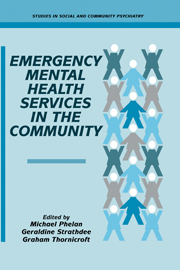Book contents
- Frontmatter
- Contents
- Contributors
- Foreword
- PRINCIPLES AND POLICIES
- 1 The scope and limitations of emergency mental health services in the community
- 2 Service models in emergency psychiatry: an international review
- 3 Users' perspective on emergency needs
- 4 Legal aspects of mental health emergencise
- 5 The economics of mental health emergency services
- 6 Suicide prevention
- 7 Using the crisis
- 8 Community assessment of crisis
- CHALLENGE OF IMPLEMENTATION
- Index
6 - Suicide prevention
from PRINCIPLES AND POLICIES
Published online by Cambridge University Press: 28 October 2009
- Frontmatter
- Contents
- Contributors
- Foreword
- PRINCIPLES AND POLICIES
- 1 The scope and limitations of emergency mental health services in the community
- 2 Service models in emergency psychiatry: an international review
- 3 Users' perspective on emergency needs
- 4 Legal aspects of mental health emergencise
- 5 The economics of mental health emergency services
- 6 Suicide prevention
- 7 Using the crisis
- 8 Community assessment of crisis
- CHALLENGE OF IMPLEMENTATION
- Index
Summary
Introduction
A brief summary of the epidemiological evidence of suicide, the risk factors and the strategies for preventing it is presented. This chapter begins by considering the widespread beliefs that prevention of suicide is an activity with relatively little prospect of success (Morgan, 1993) and even one which is ethically misguided: why should anyone who wishes to do so be prevented from ending his or her own life? As social circumstances, such as unemployment, are important determinants of suicide risk, is there very little that can realistically be done by individuals – even in specialist mental health services – to reduce incidence?
Reduction in avoidable mortality is an aim of most health services and the many other government departments which deal with safety issues. For instance, death from road traffic accidents – transport and environmental departments determine safety standards on roads and in vehicles, adding considerably to the cost and inconvenience of the passenger, e.g., structural modification to vehicles, safety barriers on motorways and seat-belts in front and rear of cars. Health services have also improved techniques for managing accidents, e.g., improvements to ambulances and developments in surgical and intensive care technique. In England, this has been successful such that road traffic deaths have now been reduced to around 4000 per year. More deaths occur from suicide which, until recently, has received relatively little direct preventative attention. Suicide rates have remained at much the same level throughout the twentieth century.
- Type
- Chapter
- Information
- Emergency Mental Health Services in the Community , pp. 96 - 115Publisher: Cambridge University PressPrint publication year: 1995

